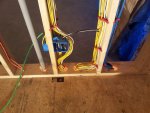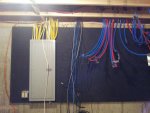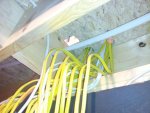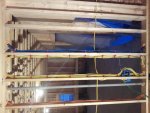Im new to the forum. I currently hold a JIT license and have just completed the hours for my Journeyman's and am in the process of sending in for the license. I have worked as an electrician for 5-6 years and am now working as an engineer in Portland, Maine.
I am having a house built (for myself) and just finished the rough-in this past weekend and the Code Enforcement Office did their initial (before insulation) inspection yesterday (Monday, Feb 4th). I was not there for the inspection but apparently the Code Enforcement Office has said they want clarification from a State Inspector and want to know if what I did was ok. What do you guys think?





What you are looking at is two 2" holes through the top and bottom plate that contain the feeds from from the panel (directly below). The holes are fire foamed. One 2" hole has ten 12/2's & four 14/2's and the other 2" hole has twelve 12/2's & four 14/2's. They are supported to the 2x6 wall using cable stackers on both sides. This was common practice and i've seen/done this hundreds of times with no issues.
The code is slightly confusing:
334.80 Ampacity. The ampacity of Types NM, NMC, and NMS cable shall be determined in accordance with 310.15. The allowable ampacity shall not exceed that of a 60?C (140?F) rated conductor. The 90?C (194?F) rating shall be permitted to be used for ampacity adjustment and correction calculations, provided the final derated ampacity does not exceed that of a 60?C (140?F) rated conductor. The ampacity of Types NM, NMC, and NMS cable installed in cable tray shall be determined in accordance with 392.80(A). Where more than two NM cables containing two or more current-carrying conductors are installed, without maintaining spacing between the cables, through the same opening in wood framing that is to be sealed with thermal insulation, caulk, or sealing foam, the allowable ampacity of each conductor shall be adjusted in accordance with Table 310.15(B)(3)(a) and the provisions of 310.15(A)(2), Exception, shall not apply. Where more than two NM cables containing two or more current-carrying conductors are installed in contact with thermal insulation without maintaining spacing between cables, the allowable ampacity of each conductor shall be adjusted in accordance with Table 310.15(B)(3)(a).
From my interpretation of the code, as long as the wires "maintain spacing" then what I did here is fine. The code does not define "maintaining space" ??? Above the panel has plenty of spacing and the cable stackers allow spacing up the entire 2x6 wall. The 2" holes pass through the plates (about 3" thick) and allow plenty of spacing around the wires. In reality I don't see an issue here, especially seeing how I wired my own house.
The feeds are already made up in the panel. Obviously any change would be a pain in the ass
Apparently the Code Enforcement Office is waiting to get clarification before I can Insulate. I guess they wanted me to drill 30 1" holes (talk about ugly and destroying my wall). Please share you opinions and help clarify this code for me.
I am having a house built (for myself) and just finished the rough-in this past weekend and the Code Enforcement Office did their initial (before insulation) inspection yesterday (Monday, Feb 4th). I was not there for the inspection but apparently the Code Enforcement Office has said they want clarification from a State Inspector and want to know if what I did was ok. What do you guys think?





What you are looking at is two 2" holes through the top and bottom plate that contain the feeds from from the panel (directly below). The holes are fire foamed. One 2" hole has ten 12/2's & four 14/2's and the other 2" hole has twelve 12/2's & four 14/2's. They are supported to the 2x6 wall using cable stackers on both sides. This was common practice and i've seen/done this hundreds of times with no issues.
The code is slightly confusing:
334.80 Ampacity. The ampacity of Types NM, NMC, and NMS cable shall be determined in accordance with 310.15. The allowable ampacity shall not exceed that of a 60?C (140?F) rated conductor. The 90?C (194?F) rating shall be permitted to be used for ampacity adjustment and correction calculations, provided the final derated ampacity does not exceed that of a 60?C (140?F) rated conductor. The ampacity of Types NM, NMC, and NMS cable installed in cable tray shall be determined in accordance with 392.80(A). Where more than two NM cables containing two or more current-carrying conductors are installed, without maintaining spacing between the cables, through the same opening in wood framing that is to be sealed with thermal insulation, caulk, or sealing foam, the allowable ampacity of each conductor shall be adjusted in accordance with Table 310.15(B)(3)(a) and the provisions of 310.15(A)(2), Exception, shall not apply. Where more than two NM cables containing two or more current-carrying conductors are installed in contact with thermal insulation without maintaining spacing between cables, the allowable ampacity of each conductor shall be adjusted in accordance with Table 310.15(B)(3)(a).
From my interpretation of the code, as long as the wires "maintain spacing" then what I did here is fine. The code does not define "maintaining space" ??? Above the panel has plenty of spacing and the cable stackers allow spacing up the entire 2x6 wall. The 2" holes pass through the plates (about 3" thick) and allow plenty of spacing around the wires. In reality I don't see an issue here, especially seeing how I wired my own house.
The feeds are already made up in the panel. Obviously any change would be a pain in the ass
Apparently the Code Enforcement Office is waiting to get clarification before I can Insulate. I guess they wanted me to drill 30 1" holes (talk about ugly and destroying my wall). Please share you opinions and help clarify this code for me.


